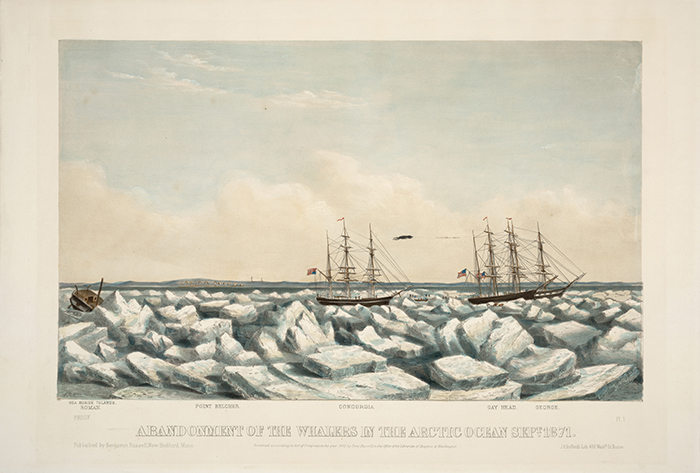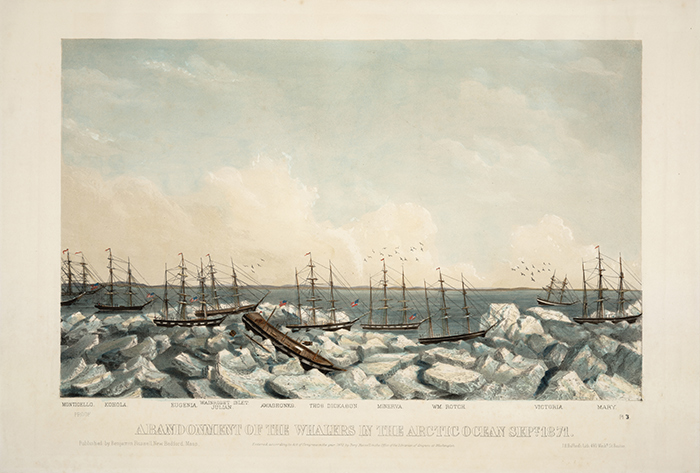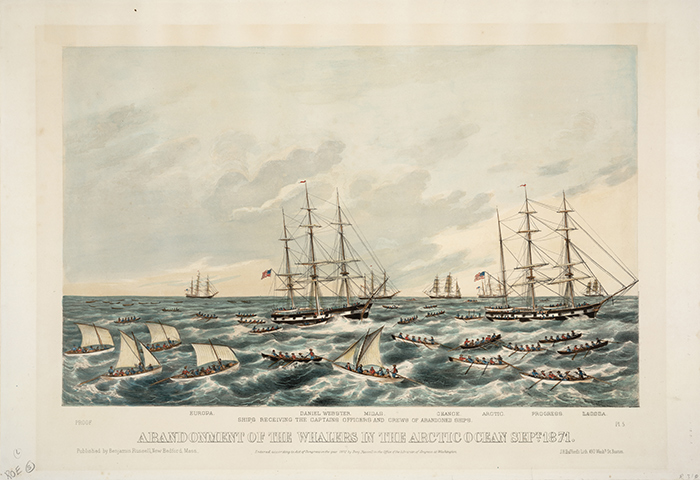The Huntington’s blog takes you behind the scenes for a scholarly view of the collections.
A Whale of a Discovery
Posted on Thu., Feb. 11, 2016 by

Plate 1 in a series of five, showing some of the 33 whaling vessels trapped in ice and the eventual rescue of the crew and passengers. Abandonment of the whalers in the Arctic Ocean Sept. 1871. Pl. 1, 1872, hand-colored lithograph. The Huntington Library, Art Collections, and Botanical Gardens. Click image to enlarge.
It’s not every day that a lithograph from The Huntington’s collections is used to publicize a major archaeological discovery. But that’s what happened last month, when the National Oceanic and Atmospheric Administration posted one of The Huntington’s prints on their website to announce they had found the hulls of two out of 33 American whaling vessels that had sunk in the Arctic Ocean in the late 19th century.
The disaster occurred in late September, 1871, when a fleet of 33 whaling vessels became trapped in icy Alaskan waters. At first their captains waited, hoping that the ice would break apart. As the seas rose and jagged ice began tearing into the vessels, the captains decided to abandon ship. Miraculously, all 1,219 persons aboard (comprising the crew and their families) were saved by nearby boats—though the fleet was a total loss.

Abandonment of the whalers in the Arctic Ocean Sept. 1871. Pl. 2, 1872, hand-colored lithograph. The Huntington Library, Art Collections, and Botanical Gardens. Click image to enlarge.
Artist John Perry Newell (1831–1898) created a series of five lithographs depicting the catastrophe in 1872, one year after it occurred, when facts about the ships were still fresh. The prints form part of the Theodore G. and Eleanor S. Congdon Maritime Collection, a group of 190 lithographs, photographs, manuscripts, publications, and other items focused on whaling, yachting, and naval battles in the United States and United Kingdom from 1700 to 1990.
Marine archaeologist and Huntington reader Bob Schwemmer happened upon the prints while doing research in the Library in 2007. He coordinates archaeological surveys along the Pacific West Coast for NOAA, and, in a stroke of serendipity, was just getting started on the search for the whaling fleet in Alaska. The meticulously drawn, hand-colored lithographs gave him some needed information.

Abandonment of the whalers in the Arctic Ocean Sept. 1871. Pl. 3, 1872, hand-colored lithograph. The Huntington Library, Art Collections, and Botanical Gardens. Click image to enlarge.
Historic images and drawings are a huge boon, says Schwemmer. “They tell us about the ships’ construction, the crew and passengers, and other clues that help us survey shipwreck sites.” The lithographs, entitled The Abandonment of the Whalers in the Arctic Ocean, provided finely wrought renderings of the boats, their names, and other valuable information—more specifics than other sources Schwemmer had consulted.
Schwemmer was struck by the emotional impact of the images. “They captured the sad loss of a whaling fleet and evoked the harsh and barren landscape of the Western Arctic,” he says.
Other materials in the Congdon collection tell equally intriguing stories about life at sea. These include an assortment of letters of marque, licenses issued to privately-owned, armed vessels to hunt down enemy ships, and a set of letters of safe conduct, documents that allowed enemy ships to traverse a territory unhindered. The letters of conduct are signed by several American presidents, including George Washington and James Buchanan.

Abandonment of the whalers in the Arctic Ocean Sept. 1871. Pl. 4, 1872, hand-colored lithograph. The Huntington Library, Art Collections, and Botanical Gardens. Click image to enlarge.
A particularly unusual item is a bound volume of four lithographs displaying a famous battle near Boston Harbor between the U.S.S. “Chesapeake” and H.M.S. “Shannon” during the War of 1812. It hails from the personal library of King William IV (1765–1837) of the United Kingdom.
There are also other documents about American whaling, a practice that reached its peak in the mid-19th century. Among the treasures are 18th-century engravings showing how sailors caught and processed the whales aboard the vessels, and handwritten letters describing their experience. “If you’re looking for illustrations for a book on whaling, this is one-stop shopping,” says Mario Einaudi, the Kemble Digital Project library, who catalogued the collection.
When the U.S. whaling fleet went down in Alaskan waters, whaling in this country was already on the decline. The sinking—along with petroleum’s growing importance—contributed to the whaling industry’s demise.
The objects in The Huntington's Congdon Maritime Collection offer a vivid reminder of a bygone chapter in U.S. maritime history.

Abandonment of the whalers in the Arctic Ocean Sept. 1871. Pl. 5, 1872, hand-colored lithograph. The Huntington Library, Art Collections, and Botanical Gardens. Click image to enlarge.
Linda Chiavaroli is a volunteer in the office of communications and marketing.